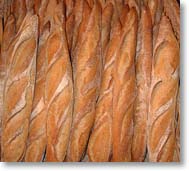 |
 |
 |
| |||||||||||||
|
|||
Beware of the French Baguette!by Marguerite Czarnecki A baguette is a thin and crusty long loaf, so named from the word that means "wand". In truth, the bread is somewhat like a magical wand, replete with charming images and myths. A good baguette is the result of a perfect balance between the crust and a soft interior, the mie. Though originating from Paris, baguettes can be found everywhere in France, and now (theoretically) anywhere in the world, as the demand has grown to a fever pitch. 
Classically, the bread is white. But many fancy types are also offered to the customer: au levain (sourdough), campagne (mixed with rye flour 5 to 10%), complète (whole wheat), ficelle (thinner), and viennoise (with milk and a little sugar) — among others. The list is long: good information on baguettes is available in Patricia Wells' Food Lover's Guide to Paris, in her chapter about bakeries. (See also the introduction by Linda Dannenberg on Bakeries and Pastry-shops in Paris.) People throughout the world dream of the baguette. Waitresses of popular restaurants in the Quartier Latin contemplate with a proud smile a group of Japanese tourists asking for their "bread basket" to be refilled. As they bring another helping, perhaps one of them will whisper to a French customer nearby, "They eat it like cakes!" Or perhaps it is the mythological image of a clochard (Parisian homeless person) lying along the Seine, contentedly partaking of a piece of bread with camembert and red wine, which inspires hundreds of tourists to park themselves on the benches of public gardens — obviously blissful as they bite, chew and swallow their picnic meal. If their moveable feast is perchance also blessed with a beam of sunshine, they have already found their way into Heaven: Springtime in Paris! The image of the baguette as a symbol of Paris has even been popularized in the movies: in Everybody Says I Love You, we watched Woody Allen, this pure product of American culture so enamored with that of the Old World, walking — just like a "real Parisian" — on a bridge, his baguette unsanitarily held under his arm. 
You won't find a good baguette here easily (although one made by Alberto — sold at Fairway on Broadway — is excellent). What makes the technical difference? At Kayser's, opened five years ago on rue Monge in Paris, Baker Damien will tell you: "First, the flour is severely controlled, coming from a very specific part of France (Gâtinais, south of Paris) where crops are grown without pesticides, then carefully processed by the miller, without any additive. Second, a slow rising is necessary, which means a good process. Many bakers may use only yeast, but Eric Kayser gave up yeast. Instead, he makes all his bread and viennoiseries from natural liquid leaven, so that the acidity is lower than when using leaven from recycled dough. Third, since 'a baguette has only four hours to live', you have to bake it en continu (on a continuous basis) during the night for the morning customers, in the morning for the daytime customers. There is no freezing or quick-processing for high quality bread, 'just love and time'." To that I would counter that even a piece of stale bread tastes great at Kayser! As a reply, Damien merely smiles and says nothing: the line of 10 to 15 people waiting patiently is a better answer, as well as the other shops which have propagated from this place, selling his baguettes as far away as Miami (FL), Japan, and Israel. Besides Kayser, many other bakers in Paris make wonderful, tasty baguettes. Patricia Wells is an avid explorer, and her guide is quite useful. One way to gauge the quality of a boulangerie? Just check out the line of customers, and also the cashier's face: deeply satisfied that she is giving the customer something unique pour son argent. So then, what could be the trouble with the French baguette? Everyone likes it! The more you like it, the more you will eat. Truth be said, you will love it. So many charming American ladies soon become like a Renoir, which is still attractive (even if not fashionable in these times of slim figures), then like a Rubens, which is slightly less attractive. The final testament comes when they board the plane back to the U.S., and might have to pay an extra fare for themselves — so good is the bread!
Copyright © 2002 Marguerite Czarnecki — All Rights Reserved. Reproduced with permission of the author. Marguerite Czarnecki is a recently retired teacher of French language and literature at a public lycée near Paris. She has graciously furnished this article for the enjoyment of our visitors. We invite your feedback, and your encouragement to Marguerite to continue writing about her perspectives on Paris! Image sources: Photos of the Kayser bakery kindly provided by Silvan Fabrice. Copyright 2002 - All Rights Reserved.
|
||||||||||||

|
||||||||||